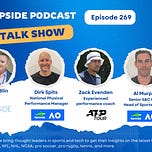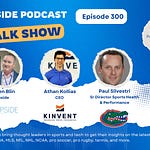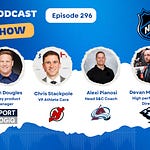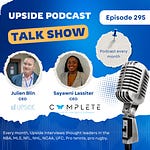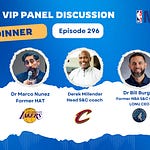This week we had the honor to interview a group of ATP sports performance experts in pro tennis.
Al Murphy, senior S&C coach at Tennis Australia. Al works with tennis players such as Rinky Hijikata, Emerson Jones and Aleks Vukic. He is also the head of sports science at Tennis Australia.
Zack Evenden, an experienced performance coach. Zack has worked with top tennis players like Frances Tiafoe, and Michael Mmoh.
Dirk Spits, the National Physical Performance Manager at Tennis Australia. Dirk works with pro tennis players such as James Duckworth, and Ajla Tomljanovic.
You can watch the video interview below by clicking on the Youtube link. You can also listen to the audio interview by clicking on the link at the top of the page:
Here are some of the best quotes of our conversation with them:
Q1. Recovery Innovations
Al Murphy:
“When you’re on the road for forty-plus weeks of the year, recovery tools need to be portable and practical. Players can’t be dragging around bulky devices to every city, so what we’ve been focusing on are compact, travel-friendly solutions. We still lean on the basics—contrast therapy, cold water immersion—when tournaments provide them, but the newer tech that excites me is neuromodulation and cooling. We’ve trialed companies like Firefly and Pulsetto, which target nerve stimulation, and even products like the CoolMitt for portable cooling on court. The key is, if a player can pull it out of their bag anywhere in the world and use it easily, it has a real chance of becoming part of their routine.”
Dirk Spits:
“We can’t underestimate the placebo effect in recovery. A big part of our philosophy is exposing players to different modalities and letting them decide what works for them. If they believe a device is helping, that belief alone can move the needle as long as it’s safe and backed by our applied science team. But we constantly remind them that gadgets don’t replace the fundamentals. Sleep hygiene, nutrition, and mental recovery are still the foundation. As an organization we place emphasis on well-being as part of recovery hence players can be direct to mindfulness apps like Calm, Headspace, or even Healthy Minds, which tracks your stress and meditation journey. Recovery isn’t about one magic tool—it’s about building a hundred-point scale of recovery habits, and each player needs to figure out their unique mix of strategies to hit that hundred.”
Zack Evenden:
“In my experience, recovery devices are as much about psychology as physiology. Sometimes a player tries something during a good week, and from that moment on, they swear by it—even if the science says otherwise. I’ve seen guys lug NormaTec boots across continents because they believe it gave them the edge. That belief makes them more disciplined in their recovery, so in a strange way it does work. At the same time, it has to fit their personality and habits. If the tool is too complicated, too heavy, or doesn’t mesh with how they travel, it won’t last. What matters is consistency. If a player finds something they trust—whether it’s neurostimulation, ice baths, or simply meditation—they’ll stick to it, and that routine becomes a cornerstone of their performance on tour.”
Q2. Nutrition & Hydration in Extreme Conditions
Zack Evenden:
“Science gives you the framework, but execution and discipline decide whether it works. Too many players think hydration starts an hour before the match, and they’re chugging bottles courtside trying to make up for it. By then, it’s too late. Hydration is a habit—you’ve got to be ahead of it the night before and even days leading in. I’ve seen everything courtside—pickle juice, Coca-Cola, maple syrup, even pasta sauce sachets. Some of it is superstition, some of it works neurologically, but ultimately it comes down to consistency. Are you hydrated before you step on court? Are you clear-headed and fueled? That’s the difference between surviving three hours in brutal heat and completely shutting down.”
Dirk Spits:
“Cramping isn’t always about fluid loss—it can also be neurological. That’s why interventions like pickle juice or menthol lozenges work: they disrupt the brain’s cramp signal, not the muscle itself. We’ve experimented with everything from sour lollies to menthol sprays to slushies pioneered by the Queensland Academy of Sport during the Beijing Olympics. The trick is not just cooling the body, but convincing the mind that conditions are tolerable. At Tennis Australia, we’ve moved away from putting all our faith in sweat testing and focused more on day-to-day behaviors: are players eating breakfast, are they drinking with meals, are they fueling consistently? Because if you don’t store fluid properly through food and routine, you’re setting yourself up for dehydration regardless of what drink is in your bottle on match day.”
Al Murphy:
“Heat adaptation is non-negotiable. It takes at least two weeks to properly adapt to high heat and humidity, and yet every year we see players try to fly straight into Melbourne or Miami and expect to cope. They end up shocked by the conditions. We’ve had players fly from winter in Brisbane to Florida, and the first few sessions are brutal—they’re sweating buckets, struggling with the heat load. So, we use saunas, steam rooms, and staged exposure in training blocks to start that adaptation before the trip. It’s not glamorous, but it’s the difference between a player who thrives in a four-hour Australian Open marathon and one who cramps out. You can’t fake physiological adaptation—it has to be built systematically.”
Q3. AI-Driven Analytics
Zack Evenden:
“One of the first times I really saw the power of live analytics was at the Next Gen Finals, where coaches had tablets courtside. Francis was over-covering the wide serve against Ugo Humbert because he assumed the lefty pattern would dominate. But the live data showed Ugo was punishing him with flat serves down the middle. With that information, we shifted Francis’ position by just a single step. That small tactical tweak completely changed the match dynamic—suddenly the pressure disappeared. For me, that was a lightbulb moment. When the data is clear and applied in real time, it feels like cheating—in the best possible way. It’s a competitive edge that can tilt a match with just one adjustment.”
Al Murphy:
“AI will never replace a coach’s eye, but it massively accelerates the process of analysis. What used to take a staffer a week of coding can now be done in hours through machine learning and pattern recognition. That means coaches can spend their time asking better questions rather than sifting through raw video. At Tennis Australia, our data teams are feeding Hawkeye and Bolt6 information live, which gives us a tactical breakdown as the match progresses. It’s not as useful early in the match, but once trends emerge—like a serve location bias or movement pattern—we can feed coaches actionable insights faster than ever before. The impact isn’t that AI changes the role of the coach; it’s that it empowers the coach to act with sharper, real-time intelligence.”
Dirk Spits:
“The danger with AI is creating over-reliant athletes. Players must still be able to solve problems themselves under pressure. If all the answers come from a data feed or a coach whispering adjustments, they lose the resilience to adapt in the moment. I see AI as a complement—something that accelerates learning, gives us richer scouting reports, and helps coaches refine match plans. But during a five-set battle, it’s still the player’s mind that has to figure it out. Matches at the elite level are often decided by a handful of points. Sometimes the right call is to stick to the game plan and trust your instincts. Technology can inform, but it can’t replace internal decision-making under stress.”
Q4. Virtual Reality & Immersive Training
Al Murphy:
“We’ve tested VR with PhD projects using AO match data, and the technology is improving, but in professional tennis it hasn’t crossed the threshold of adoption yet. The big hurdle is buy-in from both players and coaches. Most pros still prefer time on the court or traditional film review over strapping into a headset. For serve and return training, there’s potential—especially for juniors who’ve never seen the speed or shape of a top-10 player’s ball—but in general the transfer to live hitting isn’t there yet. Until VR can replicate the sound, the feel, and the timing of a real rally, it will remain on the fringes.”
Dirk Spits:
“I see VR as a tool with niche value rather than a mainstream training method. It might be powerful for juniors stepping up in competition—they could virtually experience what it’s like to face Novak Djokovic’s serve before ever standing on that baseline. It could also be a rehab tool for injured players who can’t hit balls but want to stay mentally sharp. But for tactical awareness, I still believe in old-school methods: players should be watching more tennis, studying patterns with their coach, and having real dialogue about how to construct points. VR can simulate, but it can’t yet replicate the sensory richness of live tennis—the sound, the timing, the depth perception. For me, film study is still the superior tool for developing tactical intelligence.”
Zack Evenden:
“For some players—especially those who are younger, injured, or into gamification—VR can keep them engaged and give them decision-making reps off court. But at the end of the day, tennis is a game of feel. You have to hear the ball, feel the spin, and judge the pace in real time. No VR system has captured that yet. I see it more as a supplemental tool, something you plug into very specific situations, rather than a core part of development. In other sports like Formula One or the NBA, VR is world class because the environments are more controlled. But in tennis, nothing will replace standing on the court and facing the reality of a live ball under pressure.”
You may also like:
🔥Upside ATP/WTA Group Chat with Al Murphy (Tennis Australia), Abdul Sillah & Zack Evenden on Training, Rehab, Sleep management, Mental Toughness & Innovation in Pro Tennis.
This week we had the honor to interview a group of ATP/WTA sports performance experts in pro tennis.
🎾 Upside ATP/WTA Group Chat with Al Murphy (Tennis Australia), Abdul Sillah & Mark Kovacs on Balancing Recovery with Packaged Schedule, Adapting Training to Modern Tennis, and More.
This week we had the honor to interview a group of ATP/WTA sports performance experts in pro tennis.

